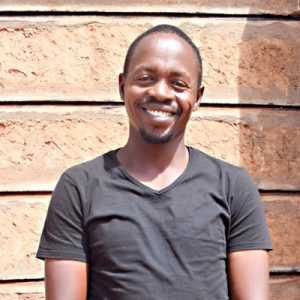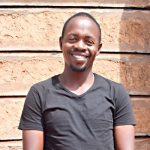Project Updates
August, 2020: Through Their Eyes: COVID-19 Chronicles with Peter Muthusi
This post is part of a new series by The Water Project meant to highlight the perspectives and experiences of the people we serve and how the COVID-19 pandemic is impacting them. We invite you to read more of their stories here.
Our team recently visited Kyetonye to conduct a COVID-19 prevention training and monitor their water point. We checked in on the community and asked how the pandemic is affecting their lives.

It was during this most recent visit that Peter Muthusi shared his story of how the coronavirus has impacted her his life.
Our field officer met Peter outside his home to conduct the interview. Both our staff member and Peter observed physical distancing and other precautions throughout the visit to ensure their health and safety. The following is Peter's story, in his own words.
How has COVID-19 impacted your family?
"Fear and anxieties around the disease and the future have been heightened due to the closure of businesses. Following the rise of cases daily, we are afraid of contracting the disease, and this has led to loneliness as we are not interacting with our neighbors as we used to. Unreliable source of income at this time has resulted in family conflicts and disagreements because of lack of money. Not being able to speak to friends and meeting them regularly is hard. We feel like we are disconnected from society, and we are wondering when the situation will normalize."
What steps is Kenya taking to prevent the spread of the virus?
"To stop the spread of the virus, Kenya has been conducting sensitization training of health care workers in Kenya. Frequent health education campaigns have been airing on media outlets to inform citizens on how to protect themselves by wearing masks all the time, washing their hands and avoiding crowded places. Quarantine facilities have been set up to ensure the victims of the virus are isolated for fourteen days. Contact tracing has also been going on to prevent the spread of this virus."
Since the outbreak of COVID-19 in Kenya, has fetching water changed for you because of restrictions, new rules, or your concerns about the virus?
"When going to the water sources we have been observing government regulations like wearing masks and social distancing. We have established handwashing stations near the wells to ensure each member washes their hands before handling the pump."
How has having a clean water point helped you through the pandemic so far?
"Despite the challenges, we are very thankful to The Water Project and Africa Sand Dam Foundation for empowering us with skills that have been applicable during this pandemic. Training such as smart agriculture practices, soap making, and construction of tippy taps have all boosted our survival capacity during this time. Both sand dam and the well are saving us time and enabling increased food production and tree planting for soil conservation. We have been using the water to plant vegetables such as kales, spinach, onions, and tomatoes, which have helped in supplementing our diets during this period."
How has getting food been at this time?
"At the onset of the virus in our country, we had a great harvest which I stored in my granary. Had there been market days, I would sell some of my farm products to get some income. Unfortunately, we had no funds to purchase pesticides. Weevils have destroyed our food in stores, and we are currently facing starvation."

June, 2020: COVID-19 Prevention Training Update at Kyetonye Community
Our teams are working on the frontlines of the COVID-19 pandemic. Join us in our fight against the virus while maintaining access to clean, reliable water.

We are carrying out awareness and prevention trainings on the virus in every community we serve. Very often, our teams are the first (and only) to bring news and information of the virus to rural communities like Kyetonye, Kenya.
We trained community members on the symptoms, transmission routes, and prevention of COVID-19.
Due to public gathering concerns, we worked with trusted community leaders to gather a select group of community members who would then relay the information learned to the rest of their family and friends.

We covered essential hygiene lessons:
- Demonstrations on how to build a simple handwashing station
- Proper handwashing technique
- The importance of using soap and clean water for handwashing
- Cleaning and disinfecting commonly touched surfaces including at the water point.

We covered COVID-19-specific guidance in line with national and international standards:
- Information on the symptoms and transmission routes of COVID-19
- What social distancing is and how to practice it
- How to cough into an elbow
- Alternative ways to greet people without handshakes, fist bumps, etc.
- How to make and properly wear a facemask.
During training, we installed a new handwashing station with soap near the community’s water point,

Due to the rampant spread of misinformation about COVID-19, we also dedicated time to a question and answer session to help debunk rumors about the disease and provide extra information where needed.
Water access, sanitation, and hygiene are at the crux of disease prevention. You can directly support our work on the frontlines of COVID-19 prevention in all of the communities we serve while maintaining their access to safe, clean, and reliable water.

October, 2019: Giving Update: Kyetonye Community Sand Dam
A year ago, your generous donation helped Kyetonye Community in Kenya access clean water.
There’s an incredible community of monthly donors who have come alongside you in supporting clean water in Kyetonye. Month after month, their giving supports ongoing sustainability programs that help this community maintain access to safe, reliable water. Read more…

March, 2019: New Pictures for Kyetonye Community
In the most recent update we sent on January 31, we noticed that some of the pictures didn't look quite right. After checking further we found that pictures of another community were mixed in with the correct pictures of Kyetonye! We've fixed the error and have posted the correct pictures. And we're excited to share the community has received their first rainfall which is filling the sand dam and storing water which will be easily accessed via the well and hand pump. Even during the dry parts of the year, Kyetonye will have water.

January, 2019: Kyetonye Community Sand Dam Complete
Kyetonye Community, Kenya now has a new source of water thanks to your donation. A new dam was constructed on the riverbed, which will build up sand to raise the water table and naturally filter water. Community members also attended hygiene and sanitation training, and plan to share what they learned with their families and neighbors.
Sand Dam
There were no reported challenges or delays that were reported to hinder the normal construction process of the sand dam. The group members created a schedule of attendance to ensure the project construction flows as planned. It took 81 days to complete the construction of both the sand dam and the adjacent hand-dug well.
"I intend to farm a lot now that the sand dam was constructed near my homestead," said Jackson Mwasa. "There's a lot of clean water at the shallow well as plenty of water was harnessed by the sand dam due to the recently experienced rains."

Yes, the water flowing from the dam is supposed to be there. As it flows through the dam, sand is building up behind the wall! This sand will store water during the coming dry seasons.
The Process:
The community members collected all of the local materials like rocks and sand that were required for successful completion of the dam. They also provided unskilled labor to support our artisans. The collection of raw construction materials takes longer than the actual construction. For a super large sand dam, materials collection could take up to four months.

Siting and technical designs were drawn and presented to the Water Resources Management Authority and a survey sent to the National Environment Management Authority for approval before construction started. Once approved, we established firm bedrock at the base of the sand dam wall. In the absence of good bedrock, excavation is done up to a depth at which the technical team is satisfied that the ground is firm enough to stop seepage.

Then mortar (a mixture of sand, cement, and water) is mixed and heaped into the foundation. Rocks are heaped into the mortar once there is enough to hold. Barbed wire and twisted bar are used to reinforce the mixture. Once the foundation is complete, a skeleton of timber is built to hold the sludge and rocks up above ground level. The process is then repeated until a sufficient height, width and length are built up. The vertical timber beams are dismantled and the dam is left to cure.
As soon as it rains, the dam will begin to build up sand and store water. With this water, the surrounding landscape will become lush and fertile.

It could take up to three years of rain (because sometimes it only rains once a year!) for this sand dam to reach maximum capacity. It is 26.55 meters long and 6.2 meters high and took 650 bags of cement to build.
Sand dam construction was undertaken simultaneously with the construction of a hand-dug well that will give community members a safe method of drawing water. As the sand dam matures and stores more sand, a huge supply of water will be available for drinking from the adjacent hand-dug well.
To see that hand-dug well, click here.
New Knowledge
The planning of the training was conducted a few weeks prior to the date. Christine Lucas Mutheu, a WASH officer, contacted the field officer in charge of the group to organize and mobilize the group members for the refresher training. Madam Ruth Mwanzia then contacted the group members to inform them on the agreed date and planned for a centrally-based venue in which the training would occur.

The training took place at Teresiah Kilonzo’s homestead. Teresiah is a member of Ivuka self-help group. The homestead is a central venue for all the members and also it's located 10 meters away from their sand dam.
Attendance was great considering this was not our first training with the Ivuka Self-Help Group. Out of the 22 people in the group, 20 members turned up for the training. On this day of, the weather was calm and conducive for learning. The venue where the training was conducted was centrally based as it is 10 meters away from the sand dam and it was near all the members' homesteads.
The participation levels of the group members were high as all the attendees portrayed immense interest in the topics of discussion.
"The training was great as we were refreshed on a lot of information taught in the previous training which we had forgotten," said Raphael Musyoka.

People attending were trained on topics including:
– cleaning latrines
– water treatment
– waste disposal
– how diseases spread
– how to make soap
The training went on smoothly without any major challenges coming along the way, this made the activity high successful.
Milka Mbithe, a member of this group, took the rest of the members through the demonstration on how to construct a tippy tap handwashing station while a few members competed to demonstrate to the rest of the members on the handwashing procedure. The competition made the topic interesting and at the end of it all the participants were handwashing experts!

January, 2019: Kyetonye Community Sand Dam Project Underway
A severe clean water shortage in Kyetonye Community still affects hundreds of people. Thanks to your generosity, we’re working to install a water point nearby and much more.
Get to know this community through the introduction and pictures we’ve posted, and read about this water, sanitation and hygiene project. We look forward to reaching out with more good news!


 Sand Dam
Sand Dam
 Rehabilitation Project
Rehabilitation Project





































